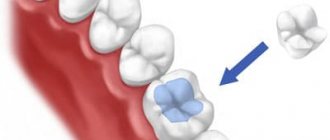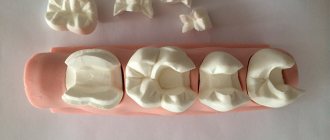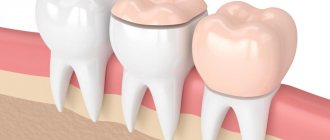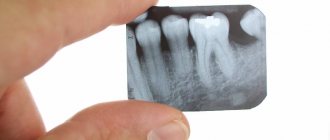- Types of products
- Ceramic inlay e max: main indications
- Contraindications for installing ceramic inlays
- Ceramic tooth inlay: advantages and disadvantages of products
- Manufacturing and installation stages
- Ceramic dental inlay: care features
If it is necessary to carry out extensive restoration, they often resort not to filling material, but to ceramic inlays (onlays).
They are one of the best methods of dental restoration and provide high-quality results. Ceramic inlays are a microprosthesis that is fixed in the tooth cavity. Such orthopedic structures are characterized by high aesthetics and durability; they are completely identical to healthy enamel, due to which they have become widespread. The e max ceramic inlay is in particular demand; it can be installed in a reliable dental clinic “A-medic”. The company's pricing policy is loyal, the cost of the service starts from 15,000 rubles. Before installing a microprosthesis, dentists conduct an examination and diagnosis to identify possible contraindications. In dentistry, a ceramic inlay is installed in just 2 stages, which allows you to quickly make your smile more attractive. An individual approach to each patient is guaranteed.
Types of products
Experts distinguish between two main types of orthopedic structures: stump and restorative. A ceramic core inlay is required to restore the tooth core for subsequent fixation of the crown. Most often it is used for prosthetics of incisors. Restorative structures are used for chewing teeth when one or two surfaces are damaged. In addition to high aesthetics, they are characterized by reliability and durability. Also, the tabs are distinguished by the material used. Below are the most common materials from which products are made.
- pressed ceramics. Products are produced using porcelain injection molding. The procedure is carried out under conditions of high temperature and pressure. Compared to orthopedic structures made of metal or zirconium dioxide, they are not as durable, but are ideal from an aesthetic point of view;
- zirconium dioxide. They are made by grinding finished metal oxide blanks. Grinding is carried out automatically using a ready-made impression (plaster model) of a damaged molar or premolar. Thanks to computer control, finished structures are characterized by high quality. Upon completion, the workpiece is fired, fusing the porcelain mass. Zirconium dioxide is a high-tech material for orthopedic structures, and therefore is in special demand. From an aesthetic point of view, such inlays are in no way inferior to porcelain products, and in terms of strength they are not inferior to metal products;
- metal. The metal most often used is gold or a silver-palladium alloy. Such designs are reliable, but do not have high aesthetics;
- metal ceramics. This is the latest orthopedic design, which is distinguished by high aesthetics, but at the same time cannot boast of proper quality. Due to thermal exposure, such products often fall out of the mouth. Most experts advise installing a structure made of zirconium dioxide or pressed ceramics rather than metal ceramics.
Hypoplasia and hyperplasia
These are rare congenital pathologies. With hypoplasia, the enamel is underdeveloped or absent altogether. With hyperplasia, its quantity, on the contrary, is excessive. Such disorders arise due to metabolic failure, general pathologies of fetal development, diseases of the gastrointestinal tract, as well as health problems that arise in women during pregnancy. Usually the problem of hyper- and hypoplasia is solved in childhood by removing “extra” or replenishing missing hard tissues. Sometimes those who had congenital hypoplasia may require more frequent remodeling therapy in adulthood.
Ceramic inlay e max: main indications
Many people mistakenly believe that ceramic inlays are a type of regular filling. In fact, they belong to the category of high-tech microprostheses. Its parameters and characteristics significantly exceed any, even the most modern and high-quality filling material. Among the main indications for installing ceramic inlays are:
- destruction of the coronal part by 30% or more;
- preparing a molar or premolar for the installation of permanent orthopedic structures, for example, bridges;
- increased abrasion of enamel;
- the presence of a large cavity that was formed as a result of an advanced carious process;
- increased sensitivity of molars or premolars to external factors;
- mechanical damage.
If, after fixing the orthopedic structure, pronounced painful sensations occur, you should not delay your visit to the dentist. Most often, pain and discomfort are a sign that the product was installed incorrectly. To avoid such situations, treatment should be carried out only in trusted dental clinics.
Let's sum it up
When a carious lesion occurs, it is important to understand why dental inlays are needed, why they are better than a composite filling, and when they are contraindicated. It is important to understand that installing such structures is not always advisable and in some cases can lead to complications, which are much more difficult to get rid of than preparing a cavity and pouring filling material into it or installing a microprosthesis on cement.
Before starting treatment, you need to choose a good doctor who will prescribe diagnostic procedures, carefully study the research results and give recommendations during the recovery period. Although almost the entire process is automated, the participation of a professional orthopedist is the key to quality therapy without unpleasant consequences.
Specialists provide a full range of dental and orthopedic services, advise patients and offer optimal solutions to problems. Sign up for a consultation by phone or leave a request on our website, and we will contact you as soon as possible.
Contraindications for installing ceramic inlays
The emax tab also has some contraindications for installation. There are no absolute contraindications, but there are relative and temporary ones, which are recommended to be eliminated before installing a ceramic onlay. Among them, insufficient oral hygiene is the most common contraindication. In this case, a specialist performs professional cleaning and prescribes additional oral care methods that can be done at home.
In case of carious lesions of the teeth, the dentist carries out treatment, and after it proceeds to install the structure. Experts do not recommend installing onlays on the last molars (“eights”). They do not perform a chewing function, so in case of severe destruction, the easiest way is to completely get rid of them without spending time on restoration.
It will not be possible to carry out the installation if only one wall of the tooth remains (at least two remaining walls are required). Problems can arise when the cavity depth is insignificant (less than 2 mm) or the presence of pathological cavities that go deep into the dentin. For bruxism (teeth grinding), the installation of pads is not recommended, since they will quickly wear out, which will significantly reduce the service life. However, you can use a special device (night guard) that will prevent the teeth of the lower jaw from rubbing against the teeth of the upper jaw.
Erosion
Looks like areas of damaged enamel with a changed shade. In the affected areas, during erosion, hard tissues soften, gradually collapse, and a cavity is formed that reaches the dentin. At this stage, the tooth begins to hurt, react to any irritants, and the defect itself becomes clearly visible. Erosion has several possible causes:
- frequent consumption of sour or sweet foods;
- brushing teeth with hard brushes or pastes with an abrasive effect;
- low calcium content in hard tissues (due to metabolic disorders, pregnancy, certain diseases).
Erosion looks like a spot with a smooth, non-shiny surface. It is treated by performing remineralization and tooth restoration. It is important to find and eliminate the cause of the defect. If this is not done, erosion will appear in new places.
Ceramic tooth inlay: advantages and disadvantages of products
Currently, ceramic onlays are the most common method of restoring incisors, molars or premolars; they are recognized as reliable and durable. Unlike composite fillings, they are not made in the patient’s mouth, but in isolation, in a dental laboratory (using impressions). This allows you to create an anatomically correct tooth shape with increased accuracy. This factor is very important for the area of contact with the adjacent incisor, molar or premolar. The use of ceramic inlays makes it possible not to resort to crowns if the root bases of the teeth are intact. The main advantages of the products include:
- high aesthetic qualities. Ceramic onlays are no different from natural molars or premolars. The material fully matches their visual characteristics. Only a specialist can notice the difference upon careful close examination;
- durability (compared to a conventional filling). If you follow all the recommendations prescribed by your doctor, the orthopedic design can last more than 10 years. For comparison, a regular filling lasts about 3-4 years;
- no changes in appearance. Ceramics do not darken over the course of a year, so the original color remains intact for the entire duration of wear. It is completely resistant to dyes and other external factors;
- no shrinkage and polymerization after fastening. The main factor influencing the development of secondary carious lesions is pathogenic microorganisms that enter the gap between dentin and filling material. It occurs as a result of shrinkage of the filling. Under the influence of ultraviolet radiation, the filling significantly decreases in volume and sags. e max structures retain their dimensions and do not change during the manufacturing and installation process. Their grinding occurs at the same time as the tooth tissues;
- complete safety. The material does not have a negative effect on the human body and does not provoke the development of allergic reactions;
- high strength. Unlike conventional fillings (light, chemical), the inlay is more securely fixed and is characterized by increased resistance to mechanical and thermal stress.
The emax ceramic inlay has no significant disadvantages. Some are confused by the time spent on manufacturing and installing orthopedic structures, which, unlike conventional fillings, require several visits to the dentist's office. Relative disadvantages include the high price (compared to inlays made of other metals). It is worth noting that their quality, aesthetics and long service life justify their relatively high cost.
tabs. orthopedics
ORTHOPEDIC TREATMENT OF PATHOLOGY OF DENTAL HARD TISSUE USING INLOTS
Classification of tabs
Tab
- a microprosthesis that fills a defect in the crown of a tooth, restoring its anatomical shape.
The inlay is a filling made in a laboratory. Unlike the therapeutic treatment of defects in the crowns of teeth, when the filling material is introduced into the tooth cavity in a plastic state, the inlay is introduced into the formed cavity in a solid state. Therefore, orthopedic treatment using inlays has obvious advantages and ensures:
• a strong connection of the inlay with the dental tissues due to the precise fit of the mating surfaces;
• the possibility of reliable restoration of interdental contact points, corners and tubercles of tooth crowns, taking into account the age and individual characteristics of natural teeth; • prevention of caries relapse by compensating for the shrinkage of the material during the manufacture of the inlay, constancy of the inlay’s volume and its precise marginal fit; • wear resistance and durability of the insert due to high mechanical strength; • color stability due to the denser structure of materials formed in the laboratory. For these reasons, replacing defects in hard dental tissues with inlays in many cases turns out to be more reliable than filling. Depending on the method of transmitting chewing pressure, microprostheses are classified:
• into restorative
- normalize the chewing pressure exerted on the periodontal tissues through the tooth on which they are applied;
• loading
- used for partial restoration of dentition as a support for bridges and additionally loading abutment teeth;
• distributing
- redistributing chewing pressure when splinting teeth.
In this regard, inlays are used:
• as independent structures for restoring the shape, function, and aesthetics of damaged tooth crowns (with IROPZ values from 0.3 to 0.6): - for carious lesions, especially in cases where tooth filling is ineffective ( cavities in the area of the necks of the teeth, chewing tubercles, corners and cutting edges of the front teeth);
— for defects of hard tissues of non-carious origin (wedge-shaped defects, increased abrasion of hard tissues, traumatic defects); • as elements of pinned teeth or an artificial stump with a pin; • as supporting elements of short bridges (no more than 1-2 extracted teeth); • as elements of splinting structures in the treatment of periodontal diseases. Contraindications to the use of inlays:
• small-sized carious cavities (with IROPV values less than 0.3);
• significant destruction of the coronal part of the tooth with IROPV values greater than 0.6; • teeth with defective (fragile, discalcified) hard tissues; • teeth with poorly accessible cavities. It is proposed to classify inlays according to the following criteria:
• topography of the defect;
• designs; • materials; • manufacturing methods. Classification of inlays according to the topography of the defect (classification of cavities for inlays)
The most common cause of defects in the crown of teeth is caries. In this regard, from the point of view of microprosthetics, classification of caries according to topographical criteria is of great importance.
An example of such a classification is the classification of G. Black (1891)
, in which all carious cavities, depending on their location, are divided into 6 classes.
The main advantage of this classification is its ease of use in the work of a dentist. Having established which class the cavity belongs to, it is easy to predetermine the typical formation of this cavity to create the most favorable conditions for fixing the inlay and preventing the possibility of secondary caries. From a practical point of view, it is easier to navigate the localization of cavities if, instead of classes, we use the letter designation of the surfaces on which the cavities are located (Boyanov B., 1960):
•
O
- cavities on the occlusal (chewing surface);
• M
- cavities on the medial surface;
• D
- cavities on the distal surface;
• MO
- cavities that simultaneously cover the medial and occlusal surfaces;
• MOD
- cavities localized on the medial, occlusal and distal surfaces.
Classification of inlays by design
Depending on the degree of destruction of the coronal part of the tooth and the method of placing the microprosthesis in hard tissues, inlays can replace missing tissue to a greater or lesser extent.
There are four main types of inlay designs (Fig. 1-1): • inlay
- a microprosthesis located centrally and not affecting the cusps of the tooth, the least invasive (Fig. 1-1, a);
• onlay
- a microprosthesis that affects the internal slopes of the tubercles in the form of an overlay (Fig. 1-1, b);
• overlay (overlay)
- a microprosthesis covering from 1 to 3 tubercles.
The structure covering 4 tubercles can already be classified as three-quarter crowns (Fig. 1-1, c); • pinlay (pinlay)
- a microprosthesis strengthened in the tooth using pins (pins) located in the hard tissues of the tooth (Fig. 1-1, d). When making such structures on chewing teeth, as a rule, all the tubercles are covered. On the front teeth, it is possible to make a pinlay while preserving the vestibular surface and cutting edge. Thus, pinlay inlays on incisors and canines resemble a half-crown with a pin.
Rice. 1-1. Types of microprostheses: a - inlay - located inside the tooth crown; b - onlay - used when it is necessary to restore most of the chewing surface of the tooth crown; c — overlay — covers the side walls of the tooth crown; g - pinlay - prosthetic tab with a pin
Classification of inlays depending on the material
Depending on what material is used to make inlays, they are divided into:
• metal - made of titanium;
• plastic (acrylic series, polyurethane series, nylon, etc.); • ceramic - from classic porcelain, titanium oxide, zirconium oxide; • composite (keromer); • combined - metal-composite, metal-ceramic.
The type of material for the manufacture of inlays determines the features of the formation of the cavity for the inlay and its design features, the features of the clinical and laboratory stages and the method of manufacturing the inlay. Regardless of the material for making the inlay, its design features, or manufacturing method, at the first clinical stage, after a thorough clinical examination, diagnosis and drawing up a treatment plan, the cavity is prepared for the inlay. Preparing a cavity for an inlay
This is an operation of excision in a certain sequence of hard tissues of the tooth crown to give the cavity the desired shape. Like any surgical intervention, preparation of a cavity in vital teeth under an inlay may be associated with the development of early or delayed complications: • postoperative tooth sensitivity; • opening of the tooth cavity; • acute and chronic pulpitis; • secondary caries. The development of complications may be due to the action of local damaging factors: mechanical trauma, drying, hyperthermia, vibration, microbial invasion. Therefore, to prevent the development of complications, the formation of cavities for inlays in teeth with preserved pulp is performed with adequate pain relief, in compliance with the general rules, principles and preparation regimes.
• Preparation of vital teeth for inlays, more than for other types of orthopedic structures, is associated with the risk of damage to the pulp (traumatic pulpitis). Therefore, when preparing a cavity for an inlay, it is necessary to take into account the anatomical and topographical features of the tooth being prepared: the structure and thickness of hard tissues in different areas, the topography of the tooth cavity. Excision of hard tissues should be carried out under X-ray control and taking into account safety zones (Abolmasov N.G., Gavrilov E.I., Klyuev B.S., 1968, 1984), with control of the depth of preparation. • Dissection should be carried out intermittently, with well-centered, sharp instruments, under full air-water cooling (50 ml/min). The water temperature should not exceed 35 °C. • When preparing, it is necessary to observe the speed modes of preparation for enamel and dentin. • To prevent the development of secondary caries, it is necessary to control the quality of removal of infected dentin. • After preparation, the prepared dentin must be protected. • Preparation of a carious cavity consists of the following stages:
— excision of all hard tissues affected by the carious process and complete removal of infected dentin (necrotomy);
— preventive expansion of the cavity; — formation (special preparation) of a cavity of the desired shape. When forming cavities for inlays, carbide and diamond burs of the following shapes are used: spherical, cylindrical, cone-shaped, flame-shaped. By sequentially using diamond and carbide burs of the same shape and size, the most optimal conditions for preparation are created. Removal of infected dentin and preliminary formation of a cavity in dentin is recommended to be carried out using carbide burs with a small number of blades. At the main stage of cavity formation, it is advisable to use diamond burs, at the final stage - carbide burs with a large number of blades (finers) or diamond burs with red markings. General principles of forming cavities for inlays
The main features of preparing teeth for inlays, as opposed to fillings, are the creation of relative parallelism of the side walls for the possibility of introducing the finished structure, as well as the need for preparation to a depth that ensures sufficient strength of the inlay.
To ensure reliable fixation of the inlay while maintaining cavity edges that are resistant to chewing pressure and to prevent relapse of caries during cavity formation, certain principles must be observed.
• The cavity is given the most appropriate shape, such that the insert can be easily removed from it in only one direction. In this case, the vertical walls of the cavity should be parallel or slightly diverge (diverge). The slope of the walls is not a constant value and can vary depending on the depth of the cavity: for superficial cavities the slope should be less, for deep ones it should be greater. • The bottom and walls of the cavity should be able to withstand chewing pressure well, and their relationship should contribute to the stability of the inlay. The design of the angle formed by the outer walls and the bottom of the cavity has a certain significance for stability. The angle of transition of these walls into the bottom should be clearly defined and approach a straight line. • The bottom of the cavity should be parallel to the roof of the tooth cavity and be of sufficient thickness to protect the pulp from external influences. Depending on age, the safe thickness of dentin above the pulp cavity can range from 0.6 mm for teeth whose root formation process has already been completed, and 1.4 mm for teenage and young adult teeth with wide and open dentinal tubules.
• To prevent relapse of caries, it is necessary to carry out preventive expansion of the cavity. • When forming a complex cavity that involves several surfaces of the tooth, retention elements should be created to prevent the inlay from moving in different directions. Additional retention points should be created if at least one outer wall is missing or its height is insignificant. Fixation elements can have different shapes: cross-shaped, T-shaped, dovetail. • The cavity for the inlay must have sufficient depth with mandatory immersion into the dentin. • The formed cavity should be asymmetrical or have additional recesses that serve as guides when inserting it into the cavity. There should be no undercuts that would interfere with the removal and insertion of the inlay. In each specific clinical case, the method of preparing hard dental tissues for an inlay will differ depending on the class of hard tissue defect and the material used to make the inlay. Thus, the peculiarities of cavity formation in the manufacture of metal inlays include the creation of a bevel (rebate) in the enamel with a width of at least 0.5 mm at an angle of 45° relative to the internal walls of the cavity, which ensures an accurate marginal fit of the inlay to the enamel, increasing its retention area ( Fig. 1-2).
Rice. 1-2. The finally formed cavity with the creation of a bevel (rebate) in the manufacture of a metal inlay
When making metal-free inlays, creating bevels in the enamel is contraindicated due to the properties of the materials - their fragility in the presence of a thin layer in the area of the transition to the tooth enamel. In addition, when making metal-free inlays, the internal corners of the cavity should be slightly rounded, the outer boundary of the cavity should be within the enamel (Fig. 1-3). When forming a cavity for composite, ceramic inlays, the edges of the cavity are not finished to ensure a high degree of fixation.
Rice. 1-3. The final formed cavity for the manufacture of a non-metallic (ceramic, composite) inlay
Preparation of cavities of the 1st class according to Black
Class 1 cavities (Fig. 1-4) are characterized by the preservation of all outer walls, which, if the cavity is formed correctly, prevent displacement of the inlay. The stability of the inlay is ensured by the depth of the cavity and the angle between the bottom of the cavity and its walls.
Rice. 1-4. View of a mandibular molar after completion of the formation of a class 1 cavity under an inlay
Class 1 cavities, located on the chewing surfaces of molars and premolars, are formed at the locations of fissures and intercuspal fossae. The cavities are given a typical shape: they should follow the fissure pattern without the formation of sharp corners (see Fig. 1-4). When forming a cavity, elements are created (bottom, walls of the cavity, bevels, etc.) that have a certain functional significance. The main wall of the cavity, which takes on most of the chewing pressure, is the bottom. It is formed parallel to the chewing surface and perpendicular to the long axis of the tooth. The tilt of this cavity wall is permissible only towards the strong outer wall. The tilt of the cavity bottom towards the weakened wall can cause a fracture of the tooth crown. When forming deep cavities to prevent perforation, one should not strive to form a flat bottom by grinding off the hard tissues of the tooth. If the bottom of the cavity is concave, it is subsequently leveled with lining material. To prevent recurrence of caries during the formation of class 1 cavities, enamel prisms that have lost contact with dentin must be ground off. For this purpose, the enamel wall must be given the most favorable slope, taking into account the radial direction of the enamel prisms along the edge of the tooth defect.
When forming cavities of the 1st class, you should not make them with symmetrical contours (round, oval) - this will complicate the fit and may cause incorrect fixation of the inlay in the tooth crown. To add asymmetry, the cavity is slightly lengthened or expanded towards one of the fissures. If there are two or more cavities on the occlusal surface, they are combined into one. Preparation of class 2 cavities
Class 2 cavities are characterized by destruction of the contact surfaces of the chewing teeth. The preparation of a 2nd class cavity begins with separation, which is carried out with a thin diamond head to the level of the tooth neck. The separation plane must be strictly vertical or slightly inclined towards the center of the tooth crown. Then, using a fissure bur, a cavity is formed on the contact surface to create a ledge and an additional area on the chewing surface (Fig. 1-5). The gingival wall of the cavity should be located at the level of the gingival margin. An additional area on the occlusal surface is intended both for preventive expansion of the cavity and to prevent displacement of the inlay towards the missing wall. On the chewing surface, hard tissues are excised, bypassing the intact slopes of the tubercles, and the cavity acquires a complex shape, which ensures good fixation of the inlay. If both contact surfaces of the tooth crown are affected, it is necessary to form a three-sided cavity (both contact and chewing surfaces are prepared) even if there is a filling on one of the contact surfaces. In this case, separation is carried out and, according to general rules, cavities are formed on both contact surfaces, which are then connected to each other by the cavity formed during excision of the chewing groove. To prevent chipping of the vestibular or oral walls of the cavity, which are under load during chewing, it is often necessary to grind off the tubercles, then restoring them with the inlay material.
Preparation of class 3 cavities
There are three degrees of destruction of the tooth crown with caries of the contact surface:
• without disruption of the labial or oral surface;
• with damage to one of them; • with simultaneous destruction of the labial, contact and oral surfaces. Depending on the degree of destruction of the crown, the method of forming cavities changes.
When only the contact surface is affected, the cavity is formed in the form of a triangle with the apex facing the cutting edge and the base parallel to the gingival edge. The bottom of the cavity should be convex, repeating the contours of the contact surface of the crown. The formation of such a cavity is possible in the absence of adjacent teeth.
Rice. 1-5. View of a mandibular molar after preparation of a class 2 cavity for making an inlay
Rice. 1-6. View of the maxillary canine after completion of the formation of a class 3 cavity under the inlay
In case of combined lesions of the contact and oral (or labial) surfaces, the cavity is formed taking into account the insertion path of the inlay and the creation of an additional fixation platform (usually in the form of a “dovetail”). An additional cavity is created in proportion to the main one, immersing it in dentin. The transition from one cavity to another is designed in the form of a step. When forming a cavity under the inlay, cavity elements are formed, each of which carries a certain functional load (Fig. 1-6). With the simultaneous destruction of the contact, oral and vestibular surfaces, additional depressions are created in the dentin from the labial and oral surfaces to hold the inlay. At the same time, the axial wall of the cavity is preserved in the form of a roller, which will protect the pulp chamber. If there are cavities on both contact surfaces, they are connected by a fairly wide groove passing through the blind fossa.
Preparation of class 4 cavities
The nature of the formation of cavities of the 4th class depends on the structural features of the cutting edge. Teeth with destruction of the cutting edge are divided into two groups depending on its width. As a rule, teeth with a wide cutting edge are found in older people, in patients with increased wear of hard dental tissues. In such teeth, between the layers of enamel there is a fairly thick layer of dentin, which makes it possible to create a cavity or an additional fixing platform in it. In this regard, the need to prepare the palatal surface of the tooth crown is eliminated, and the inlay located on the cutting edge protects the tooth from further abrasion. The shape of the prepared main cavity located on the contact surface must be such that the path of insertion and removal of the inlay coincides with the long axis of the tooth, and the gingival wall is perpendicular to the long axis of the tooth. In addition to the main cavity, an additional platform is created in the cutting edge in the form of a groove, commensurate with the main cavity and the width of the cutting edge. This groove may end with a recess in the form of a channel, into which a pin fixed in the inlay will subsequently enter, improving its fixation, or it may move into a cavity on the other contact surface (in case of damage to both contact walls of the tooth). In teeth with a thin cutting edge, the formation of the main cavity is carried out in the middle third of the tooth crown, perpendicular to the palatal surface. This direction determines the insertion path of the tab. The bottom of the main cavity becomes the labial wall of the tooth crown. To ensure fixation of the inlay, an additional platform is formed in the area of the blind fossa at the base of the dental tubercle with immersion in the dentin. If both contact surfaces are affected with a violation of the angles of the cutting edge, the latter is used to form a step and create a saddle-shaped connection of the proximal cavities. When the cutting edge is chipped, it is ground off, creating a bevel from the oral surface. Then a cavity is formed taking into account the topography of the tooth cavity with the creation of vertical channels for the pins. The canals should run midway from the pulp to the enamel edge.
Class 5 Cavity Preparation
When forming cavities in the cervical region, it is necessary to take into account the proximity of the cavity to the equator and the danger of opening the pulp chamber located close to the surface of the tooth.
The expansion of the cavity is carried out to the greatest curvature of the tooth crown in the area of the equator and contact surfaces. The bottom of the cavity is formed convex, especially on the front group of teeth. The gingival wall is formed at the level of the gingival margin, except for those cases when there remains a section of intact hard tissue at least 2 mm wide between the edge of the cavity and the gum. The mesial and distal walls of the cavity must be at a certain angle to each other, and the wall facing the cutting edge (or occlusal surface) and the gingival wall must be parallel. This ensures retention of the tab. Protection of prepared dentin
After preparation, to protect dentin from irritating factors, its dentinal tubules are sealed using desensitizers - materials whose operating principle is based on sealing dentinal tubules in various ways. The main effect of using desensitizers is to reduce the sensitivity of prepared dentin. During the production of the inlay, the cavity formed in the tooth must be closed with a temporary filling, which protects the tooth from thermal, chemical, mechanical and microbial influences in the postoperative period.
Manufacturing and installation stages
Manufacturing and installation of an orthopedic structure is not difficult and does not take much time. At the initial appointment, the dentist examines the oral cavity to determine indications and contraindications for the procedure. If contraindications are identified, they are eliminated, after which they proceed to therapy. If necessary, endodontic treatment and hygienic treatment of the diseased tooth are carried out. By analogy with standard filling, the specialist removes all destroyed tissue from the tooth, forming an area for a microprosthesis. After this, a cast is made that exactly repeats its shape.
The production time for an emax ceramic inlay based on the impression obtained (3D modeling results) is about 5-10 days. At this time, a temporary filling material is placed in the patient's cavity. The onlay is made in laboratory conditions, taking into account the individual characteristics of the patient’s dental system. The orthopedic structure is fired and covered with layers of ceramics. At the secondary appointment, the patient’s temporary filling is removed and a finished microprosthesis is installed. It is attached using special cement, which firmly adheres to the ceramics and enamel of the tooth. This guarantees a secure fit. At the end of the process, the surface is polished. The whole procedure takes no more than 120-150 minutes.
Tooth preparation
Before installing core inlays, the tooth must be properly prepared, that is, undergo endodontic treatment
.
The canals of the tooth must be properly sealed
. The quality of the filling can be checked by x-ray examination. Next, oddly enough, the canals are unsealed to 1/2 - 1/3 of the root length. In other words, a bed is being prepared for the stump insert. The channel is given a certain taper and width. Then a silicone two-layer impression is taken, imprinting the ideal shape of the inlay. Impressions are taken from both the upper and lower jaws, since during production in the laboratory it is necessary to understand the relationship of the antagonist teeth and jaws so that the coronal part of the inlay has the required inclination, size and shape.
The tab is then fixed with cement. A day after fixing the tab, impressions can be taken for further crown manufacturing.
With high-quality and correct restoration of teeth using core inlays
, “missing” teeth, as it already seemed, will serve for many more years, fully performing their functions.
The description and photo for this clinical case were provided by ViTerra orthopedic dentist Z.E. Kadiev.
Ceramic dental inlay: care features
The ceramic inlay and onlay do not require complex care. You need to care for your teeth like you would for regular teeth - brush twice a day, use floss and mouth rinses after each meal. It is worth noting that ceramic inlays, due to their physical properties, do not require additional care (unlike light fillings) - professional cleaning.
In order to promptly detect leaks in the Emax tab, you need to regularly visit the dentist’s office (once every six months). When a dark stripe appears, there is a high probability that pathogenic microorganisms have begun to penetrate under the ceramic inlay, which provoke the development of a carious process. On average, the service life of ceramic structures is about 7-8 years. Subject to all rules and hygiene standards, as well as the absence of increased stress, they can last several years longer.
You can install a ceramic inlay in Moscow at the reliable A-Medic clinic. Qualified specialists with extensive experience work here, which guarantees a positive result. The orthopedic design is no different from natural teeth and can last for many years. In the event that there are contraindications to the installation of this product, A-Medic dentists will be able to select another method of tooth restoration.
Anchor pins for tooth restoration
Anchor pins are often used to restore pulpless teeth. Anchor pins are metal pins that are fixed into a canal to build a tooth stump for a future crown or direct restoration.
They are threaded and fixed into the root canal using special cement. At one time they were very widely used in dentistry. However, they soon began to be abandoned, and we tried to figure out why.
Positive and negative properties of anchor pins
If we talk about the advantages of using anchor pins for restoration, they include:
- strength - such pins do not break
- affordable price
- speed and ease of use
What's wrong then? Let's look at all the shortcomings:
- low connection - there is no chemical connection between the intra-root and coronal parts, so they can easily separate
- poor aesthetics, especially if the work is done on the front teeth
- high risk of root fracture, since when installing an anchor pin, tension occurs inside the tooth root, which leads to a wedging effect, plus necrosis of the tissue around the tooth root, which leads to tooth extraction
The speed of installation of the anchor pin also plays an unpleasant role here. Fast does not mean easy. After all, each anchor pin system has its own installation rules and special auxiliary tools, which, unfortunately, are often neglected.
Materials for manufacturing pin stump inlays
Stump pin inlays can be made from different materials - ceramics or metal. Stump inlays with metal pins are most often made from an alloy of cobalt and chromium and are used for the installation of metal or metal-ceramic prostheses.
Cobalt-chrome core inlays have a number of specific advantages:
- They have good biocompatibility with human body tissues;
- Stump pin inlays made of this metal alloy fit quite tightly to natural tissues and therefore, when used, the risks of caries, inflammatory processes and further tooth destruction are reduced;
- Cobalt-chrome alloy has high strength and therefore a crown installed on a pin insert made of this material will not shrink during operation.
Stump inlays made of cobalt-chrome alloy allow for proper distribution of the chewing load, which reduces the risk of cracks and tooth destruction. The advantages of inlays made from this material include their affordable cost.
Ceramic pin inlays are used for the installation of metal-free dentures. This allows you to obtain impeccable aesthetics of the restored tooth. If you place a metal stump insert under the ceramic structure, it can be quite noticeable and, of course, it will spoil the appearance of the restored tooth. Therefore, only ceramic pin inlays are placed under ceramics.











